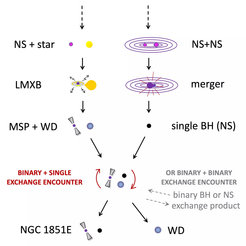Lightest black hole or heaviest neutron star?
MeerKAT uncovers a mysterious object at the boundary between black holes and neutron stars
An international team of astronomers, led by researchers from the Max Planck Institute for Radio Astronomy, have used the MeerKAT radio telescope to discover an intriguing object of an unknown nature in the globular cluster NGC 1851. The massive object is heavier than the heaviest neutron stars known and yet simultaneously lighter than the lightest black holes known and is in orbit around a rapidly spinning millisecond pulsar. This could be the first discovery of the much-coveted radio pulsar - black hole binary; a stellar pairing that would allow new tests of Einstein’s general relativity. The research was published today in the journal Science.

Neutron stars, the ultra-dense remains of a supernova explosion, can only be so heavy. Once they’ve acquired too much mass, perhaps by consuming another star or maybe by colliding with another of their kind, they will collapse. What exactly they become once they collapse is the cause of much speculation, with various wild and wonderful flavours of exotic stars being proposed. The prevailing opinion, however, is that neutron stars collapse to become black holes, objects so gravitationally attractive that even light cannot escape them. Theory, backed by observation, tells us that the lightest black holes that can be created by collapsing stars are about 5 times more massive than the Sun. This is considerably larger than the 2.2 times the mass of the sun required for neutron star collapse, giving rise to what is known as the black hole mass gap. The nature of compact objects in this mass gap is unknown and detailed study has thus far proved challenging due to only fleeting glimpses of such objects being caught in observations of gravitational-wave merger events in the distant universe.
Discovery in the mass gap

The discovery of an object in this mass-gap in our own galaxy by a team of astronomers from the international Transients and Pulsars with MeerKAT (TRAPUM) collaboration may help finally understand these objects. Their work, published this week in the journal Science, reports on a massive pair of compact stars in the globular cluster NGC 1851 in the southern constellation Columba (the dove). By using the sensitive MeerKAT radio telescope in South Africa, in combination with powerful instrumentation built by engineers at the Max Planck Institute for Radio Astronomy (MPIfR) in Bonn, Germany, they were able to detect faint pulses from one of the stars, identifying it as a radio pulsar, a type of neutron star that spins rapidly and shines beams of radio light into the Universe like a cosmic lighthouse.
This pulsar, designated PSR J0514-4002E, spins more than 170 times a second, with every rotation producing a rhythmic pulse, like the ticking of a clock. By observing small changes in this ticking over time, using a technique called pulsar timing, they were able to make extremely precise measurements of its orbital motion. “Think of it like being able to drop an almost perfect stopwatch into orbit around a star almost 40,000 light years away and then being able to time those orbits with microsecond precision,” says Ewan Barr, who led the study together with MPIfR colleague and PhD candidate Arunima Dutta.
An invisible partner
“By regularly timing the pulsar and carefully analyzing our observations, we were able to precisely pinpoint the pulsar’s location. But when we looked at Hubble images of NGC 1851, we saw nothing at that position,” explains Prajwal Voraganti Padmanabh, a postdoctoral researcher at the Max Planck Institute for Gravitational Physics (Albert Einstein Institute) in Hannover. “Hence, the object in orbit with the pulsar is not a normal star, but an extremely dense remnant of a collapsed star.” Furthermore, the observed change with time of the closest point of approach between the two stars (the periastron) showed that the companion has a mass that was simultaneously bigger than that of any known neutron star and yet smaller than that of any known black hole, placing it squarely in the black-hole mass gap.
“Whatever this object is, it is exciting news”, says Paulo Freire, of the MPIfR. “If it is a black hole, it will be the first pulsar - black hole system known, which has been a Holy Grail of pulsar astronomy for decades! If it is a neutron star, this will have fundamental implications for our understanding of the unknown state of matter at these incredible densities.”
The most exotic binary pulsar discovered yet

The team proposes that the formation of the massive object, and its subsequent pairing with the fast-spinning radio pulsar in a tight orbit, is the result of a rather exotic formation history only possible due to its particular local environment. The system is found in the globular cluster NGC 1851, a dense collection of old stars that are much more tightly packed than the stars in the rest of the Galaxy. Here, it is so crowded that the stars can interact with each other, disrupting orbits and in the most extreme cases colliding. It is one such collision between two neutron stars that is proposed to have created the massive object that now orbits the radio pulsar. However, before the present binary was created, the radio pulsar must have first acquired material from a donor star in a so-called low-mass X-ray binary. Such a “recycling” process is needed to spin up the pulsar to its current rotation rate. The team believes that this donor star was then replaced by the current massive object in a so-called exchange encounter. “This is the most exotic binary pulsar discovered yet,” says Thomas Tauris from Aalborg University, Denmark. “Its long and complex formation history pushes at the limits of our imagination.”
While the team cannot conclusively say whether they have discovered the most massive neutron star known, the lightest black hole known or even some new exotic star variant, what is certain is that they have uncovered a unique laboratory for probing the properties of matter under the most extreme conditions in the Universe.
“We're not done with this system yet,“ says Arunima Dutta. She concludes, “uncovering the true nature of the companion will a turning point in our understanding of neutron stars, black holes, and whatever else might be lurking in the black hole mass gap”.














